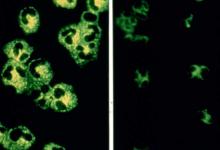Targeting GM-CSF Works in Rheumatoid Arthritis Save
Namilumab, a monoclonal antibody that targets the granulocyte-macrophage colony-stimulating factor (GM-CSF) ligand, showed promise as a treatment for rheumatoid arthritis (RA) in a phase II study.
At week 12, patients showed good improvement in disease activity with namilumab given in doses of 20, 80, and 150 mg as their Disease Activity Score in 28 joints' (DAS28) scores fell on average by -1.63, -1.47, and -1.80, respectively, compared with a moderate change of -0.99 for placebo, according to Peter C. Taylor, MD, of the University of Oxford in England, and colleagues.
And the proportions of patients reporting a decrease in pain of at least 40% were 44%, 39.1%, and 30.8% for the three treatment groups, respectively, compared with 20% for placebo, the investigators reported online in Arthritis Research & Therapy.
Despite the ever-increasing number of treatment options for the treatment of RA, additional choices are still needed because significant numbers of patients do not respond or lose their response to available agents.
The hematopoietic growth factor GM-CSF is derived from many sources such as T cells, macrophages, and fibroblasts and is present in excessive quantities in the synovium in RA. The potential effects of targeting GM-CSF were demonstrated in a previous proof of concept study with a similar monoclonal antibody (mavrilimumab).
Preliminary evidence of efficacy for targeting GM-CSF also was observed in a phase Ib trial of namilumab, although only 24 patients were included.
To explore this option in a larger cohort powered for statistical significance, Taylor and colleagues enrolled 108 RA patients from 28 sites in seven countries who had previously had an inadequate response to methotrexate or a tumor necrosis factor inhibitor. The treatment was administered subcutaneously at baseline and again at weeks 2, 6, and 10.
Participants' mean age was 48, mean disease duration was 9 years, and the majority were women.
Mean methotrexate dosage was already 16 mg/week and up to half of patients were also taking corticosteroids at baseline. Even so, the average DAS28 score at baseline was 5.66, indicating moderate to severe disease. Mean swollen and tender joint counts were 13 and 24, respectively.
The 150-mg namilumab group showed significant improvement versus placebo by as soon as week 2, after only one dose of namilumab.
Benefits specific to the highest dose were strongest on several counts. On the criteria of the American College of Rheumatology (ACR), improvements of 20% were seen in 70.8%, 52.2%, and 57.1% of the 20-mg, 80-mg, and 150-mg groups compared with 38.1% of the placebo group. ACR50 responses were observed in 20.8%, 30.4%, and 42.9% of the three treatment groups compared with 14.3% of the placebo group (P=0.049 for the 150-mg group).
As for quality of life improvements, 150 mg namilumab significantly improved scores on the Short Form (SF)-36 mental health scale (least squares mean changes from baseline were 7.8, 5.2, and 14.4 for the 20-mg, 80-mg, and 150-mg groups compared with 3.07 for the placebo group) and the SF-36 vitality scale (least squares mean changes from baseline were 12.8, 12.2, and 17.3 for the three treatment groups, respectively, compared with 6.5 for placebo).
On the validated multibiomarker disease activity score, which measures various laboratory markers such as interleukin 6, TNF receptor type I, epidermal growth factor, and serum amyloid A, changes at week 12 were:
- Placebo, -0.54
- 20 mg, -8.50 (P=0.035)
- 80 mg, -7.81 (P=0.036)
- 150 mg, -9.04 (P=0.008)
During the 12-week study period, adverse events were reported by 51.9% of patients receiving placebo and 55.6% of those given namilumab, with the most common being nasopharyngitis, dyspnea, bronchitis, and headache.
A treatment-related adverse event of particular interest was the theoretical possibility of the development of pulmonary alveolar proteinosis resulting from inadequate clearance of pulmonary surfactant protein by GM-CSF. Thus, close respiratory monitoring was done throughout the study and showed that the small numbers of patients (less than 5%) who had changes on chest radiographs, forced expiratory volume, or forced vital capacity were not related to pulmonary alveolar proteinosis, as determined by a pulmonary panel.
A limitation of the study was its 12-week duration. The number of patients achieving more stringent efficacy goals such as ACR50 was still increasing at that time point, the investigators claimed, noting that studies of other biologics have demonstrated that some patients continue to improve over 24 weeks, and that a "significant proportion" of partial responders and nonresponders at week 12 can achieve a clinical response with continued treatment.
They concluded that their findings "confirm the validity" of targeting GM-CSF in RA, and recommended that future clinical trials focus on the 150-mg dose.
The study was sponsored by Takeda.
Taylor reported no financial conflicts, but several co-authors were employees of Takeda.










If you are a health practitioner, you may Login/Register to comment.
Due to the nature of these comment forums, only health practitioners are allowed to comment at this time.